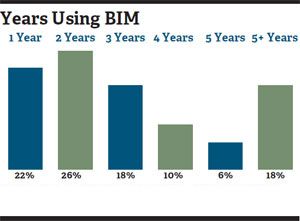The Practical And Financial Ramifications Of Adopting This New Design Model
No doubt about it, we’re living in a 3D world. Consultants and integrators in the early stages of adding BIM (Building Information Modeling) to their work flow must navigate some uncharted waters and should prepare for the impact of the initial investment and the various decisions needed to be made regarding transitions from other systems.
San Francisco-based consulting firm Charles M. Salter Associates (CMS) undertook its first Revit project about three years ago for an Autodesk installation (appropriately enough); however it remained primarily an AutoCAD house until late 2010 when the commitment was made to do a full transition to Revit, said Salter vice president Ken Graven, PE, RCDD, LEED AP.
“Pull off the bandage all at once; maintaining two separate systems will prolong the agony of making the transition,” he advised. “Our clients were working in Revit and, although it’s possible to continue in AutoCAD, we saw distinct advantages in being able to spatially locate devices, so important for the AV enduser experience. It’s also an opportunity to better coordinate with engineers on devices such as floor boxes and other infrastructure since we are all working in the same model as a single synchronized file.”
Ultimately, Graven says, Revit facilitates better coordination with fewer errors. “Concrete design decisions can be made much earlier, improving efficiency and lowering the cost of building and design effort. With fewer changes made later in the game, the process will be less tedious and project designers will be less of a burden since there will be less latearriving design information. Having a smooth design process can be equally as important as final results.”
For integrators, the obvious financial investment is a consideration, with the Revit software license itself priced at more than $6,000 per seat, he said. “Almost assuredly, any integrator will have to buy a new computer with a minimum quad-core processor, with up to 24 gigabytes of RAM. As some Revit models can be extremely large, we certainly would suggest going to higher levels of RAM so you won’t find yourself out of memory when you’re on a deadline.”
In addition to a $3,000 computer system, training should be a further consideration, Graven said. “We’ve elected to send consultants to three-day training classes at $1,100 per head. There is also the option of bringing instructors into your workplace to help set up actual Revit projects.”
CMS’ eventual goal is to phase out AutoCAD completely, he said, as the older system can be a hindrance because it is so different from Revit, although most AutoCAD drawing tools will eventually be integrated into Revit.
If all goes according to plan, Middle Atlantic Products will just have published its third generation of Revit models at press time, said marketing communications manager, Michael Cukrow. “We’ve been involved with Revit for two years. We saw what was happening, knew it would be important to the future of the industry, and wanted to react. Our partners have learned that as well.”

According to a 2010 survey by McGraw-Hill Construction, the BIM adoption rate in North America was 49 percent, and adoption among contractors has surged to 50 percent. The adoption rate is only recent, though, as the length of time companies have been using BIM shows.
When the industry first started seeing the requirement to create designs in BIM, no one was really sure exactly what should be represented, he said. “It’s as much about information as it is a 3D model. The more detail and data you put in the bigger the file size will be. If it gets too big it will run slow; the completed designs are models are incredibly complex.”
Cukrow pointed to Yankee Stadium, where everything from concrete pad and location of speakers, support beams, conduit, electrical, and ornamental elements and seating is included on the program. “There is a huge amount of detail and the goal is to find the right level of detail— too much and the design can run too slowly; too little and it won’t provide enough to avoid issues later.”
The challenge for Middle Atlantic was to weed out what was not needed, and then to ensure only critical details were included, he says. “We heard many different answers when we and others were getting started. Typically, BIM is required by the architect, and Revit is the most popular program in U.S., but there are others. When a consultant makes the investment they need to assess which platform is best for them. There are more and more global projects using other programs. And government clients may be using other software. It’s essential to know what your client requires. You have to pick your side of the fence as the software is not compatible, though steps are being taken to address this.”
Designating less complex tasks to junior designers, as is commonplace with AutoCAD, is not as feasible with Revit. “At this stage, lower level folks haven’t been trained in Revit, Cukrow says, “and the demand has not risen to a level that necessitates more than one or two Revit trained staff due to the significant investment required in software, hardware, and training.”
Integrators have more time than consultants to invest in Revit but they should start preparing themselves for when it becomes important, and learn what’s really needed to get there, Cukrow says. “BIM and Revit represent a tremendous shift in the way designs will be completed. If you’re designing a building in BIM all the trades have to get together up front and be in agreement. It’s multi-dimensional; 3D is the height, width and depth, and the fourth and fifth dimensions are cost and time. Another concept, IPD [Integrated Project Delivery] takes you from Revit throughout the entire construction stage. But that’s another stage.”
“If the audiovisual industry wants to be a fully integrated part of buildings, then we need to be fully integrated into the design and construction process,” concluded Randal A. Lemke, Ph.D., executive director and CEO , InfoComm. “The most effective way to accomplish this is by successfully participating in the BIM workflow.”
Karen Mitchell is a freelance writer based in Boulder, CO.














